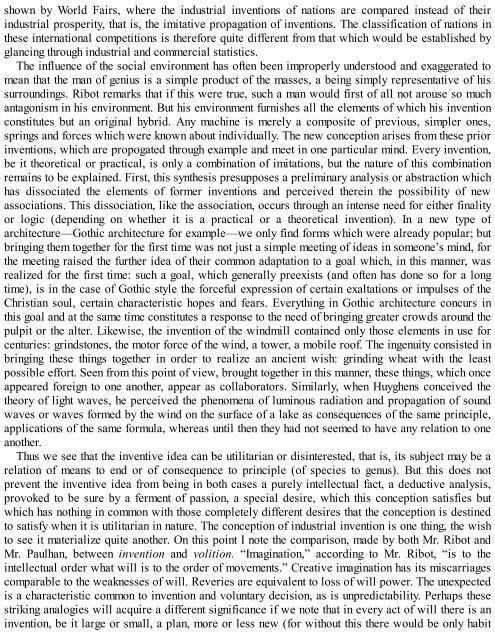3658925934
Create successful ePaper yourself
Turn your PDF publications into a flip-book with our unique Google optimized e-Paper software.
shown by World Fairs, where the industrial inventions of nations are compared instead of their<br />
industrial prosperity, that is, the imitative propagation of inventions. The classification of nations in<br />
these international competitions is therefore quite different from that which would be established by<br />
glancing through industrial and commercial statistics.<br />
The influence of the social environment has often been improperly understood and exaggerated to<br />
mean that the man of genius is a simple product of the masses, a being simply representative of his<br />
surroundings. Ribot remarks that if this were true, such a man would first of all not arouse so much<br />
antagonism in his environment. But his environment furnishes all the elements of which his invention<br />
constitutes but an original hybrid. Any machine is merely a composite of previous, simpler ones,<br />
springs and forces which were known about individually. The new conception arises from these prior<br />
inventions, which are propogated through example and meet in one particular mind. Every invention,<br />
be it theoretical or practical, is only a combination of imitations, but the nature of this combination<br />
remains to be explained. First, this synthesis presupposes a preliminary analysis or abstraction which<br />
has dissociated the elements of former inventions and perceived therein the possibility of new<br />
associations. This dissociation, like the association, occurs through an intense need for either finality<br />
or logic (depending on whether it is a practical or a theoretical invention). In a new type of<br />
architecture—Gothic architecture for example—we only find forms which were already popular; but<br />
bringing them together for the first time was not just a simple meeting of ideas in someone’s mind, for<br />
the meeting raised the further idea of their common adaptation to a goal which, in this manner, was<br />
realized for the first time: such a goal, which generally preexists (and often has done so for a long<br />
time), is in the case of Gothic style the forceful expression of certain exaltations or impulses of the<br />
Christian soul, certain characteristic hopes and fears. Everything in Gothic architecture concurs in<br />
this goal and at the same time constitutes a response to the need of bringing greater crowds around the<br />
pulpit or the alter. Likewise, the invention of the windmill contained only those elements in use for<br />
centuries: grindstones, the motor force of the wind, a tower, a mobile roof. The ingenuity consisted in<br />
bringing these things together in order to realize an ancient wish: grinding wheat with the least<br />
possible effort. Seen from this point of view, brought together in this manner, these things, which once<br />
appeared foreign to one another, appear as collaborators. Similarly, when Huyghens conceived the<br />
theory of light waves, he perceived the phenomena of luminous radiation and propagation of sound<br />
waves or waves formed by the wind on the surface of a lake as consequences of the same principle,<br />
applications of the same formula, whereas until then they had not seemed to have any relation to one<br />
another.<br />
Thus we see that the inventive idea can be utilitarian or disinterested, that is, its subject may be a<br />
relation of means to end or of consequence to principle (of species to genus). But this does not<br />
prevent the inventive idea from being in both cases a purely intellectual fact, a deductive analysis,<br />
provoked to be sure by a ferment of passion, a special desire, which this conception satisfies but<br />
which has nothing in common with those completely different desires that the conception is destined<br />
to satisfy when it is utilitarian in nature. The conception of industrial invention is one thing, the wish<br />
to see it materialize quite another. On this point I note the comparison, made by both Mr. Ribot and<br />
Mr. Paulhan, between invention and volition. “Imagination,” according to Mr. Ribot, “is to the<br />
intellectual order what will is to the order of movements.” Creative imagination has its miscarriages<br />
comparable to the weaknesses of will. Reveries are equivalent to loss of will power. The unexpected<br />
is a characteristic common to invention and voluntary decision, as is unpredictability. Perhaps these<br />
striking analogies will acquire a different significance if we note that in every act of will there is an<br />
invention, be it large or small, a plan, more or less new (for without this there would be only habit









![Genki - An Integrated Course in Elementary Japanese II [Second Edition] (2011), WITH PDF BOOKMARKS!](https://img.yumpu.com/58322134/1/180x260/genki-an-integrated-course-in-elementary-japanese-ii-second-edition-2011-with-pdf-bookmarks.jpg?quality=85)
![Genki - An Integrated Course in Elementary Japanese I [Second Edition] (2011), WITH PDF BOOKMARKS!](https://img.yumpu.com/58322120/1/182x260/genki-an-integrated-course-in-elementary-japanese-i-second-edition-2011-with-pdf-bookmarks.jpg?quality=85)





